The Moon Looms During Evening, the Mid-Autumn Sky Spits Spooky Sparks, Mars Mounts its Attack, and Jupiter Sports Spots!
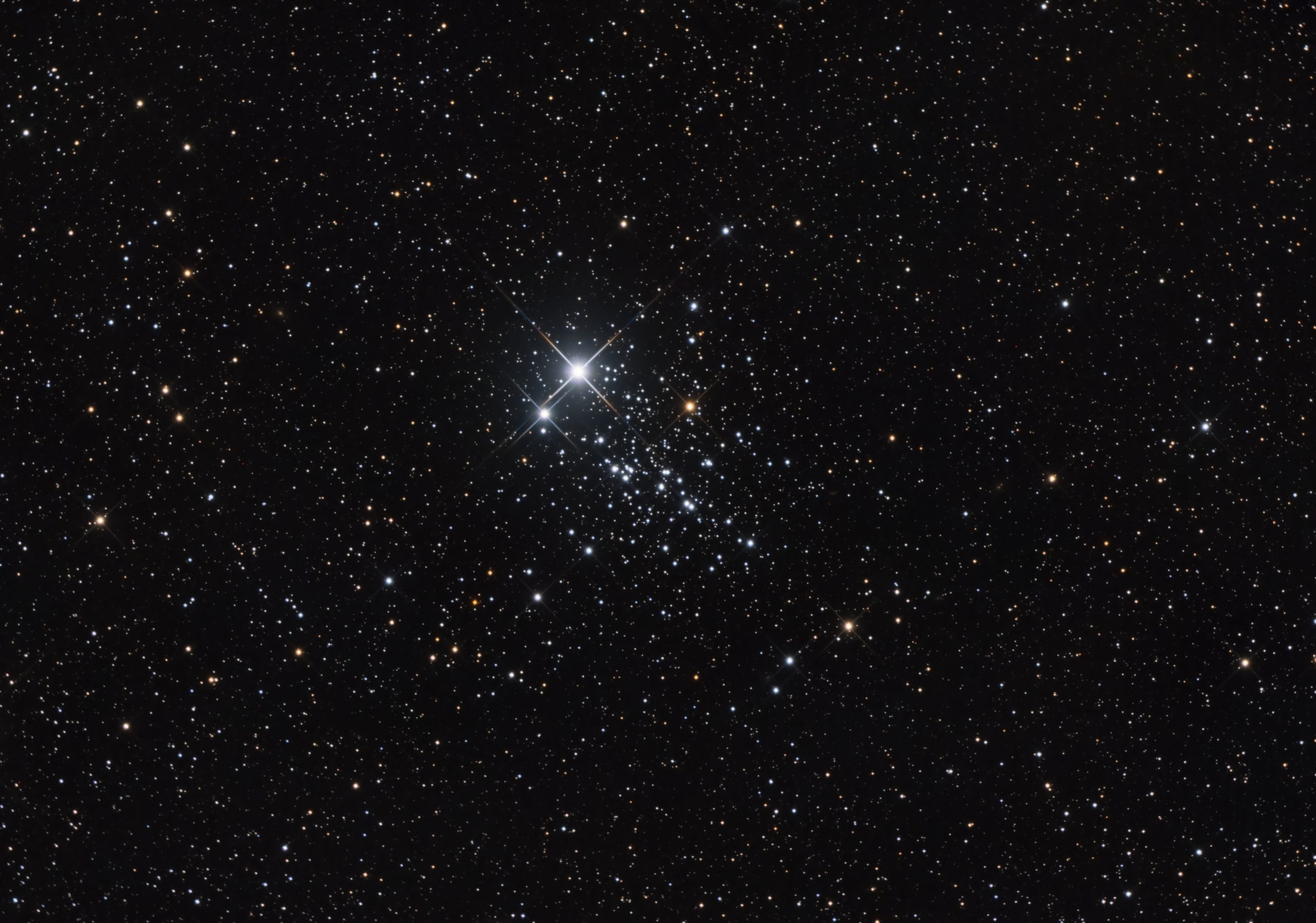
NGC 457, better known as the Owl Cluster, ET Cluster, and Dragonfly Cluster, was imaged by “Astrodoc” Ron Brecher of Guelph, Ontario. The bright stars are the eyes. The body and feet extend down to the right. Squint to see the upswept, curving chains of stars for the wings. This image covers a finger’s width of the sky left-right. View Ron’s other fine images at www.astrodoc.ca
Hello, Spooky Stargazers!
Here are your Astronomy Skylights for the week of October 30th, 2022 by Chris Vaughan. Feel free to pass this along to your friends and send me your comments, questions, and suggested topics. You can also follow me on Twitter as @astrogeoguy! Unless otherwise noted, all times are expressed in Eastern Time. To subscribe to these emails please click this MailChimp link.
If you’d like me to bring my Digital Starlab portable inflatable planetarium to your school or other daytime or evening event, or deliver a session online, contact me through AstroGeo.ca, and we’ll tour the Universe, or the Earth’s interior, together! My terrific book with John A. Read entitled 110 Things to See With a Telescope is a guide to viewing the deep sky objects in the Messier List – for both beginners and seasoned astronomers. DM me to order a signed copy!
Halloween was founded on the autumn cross-quarter day. The moon will welcome looks while it shines in the evening sky worldwide this week, somewhat interfering with the Taurids meteor shower. Three bright planets Saturn, Jupiter, and Mars will parade during evening – with two of Jupiter’s moons crossing its disk together, and Mars brightening. I also share my favorite spooky star cluster. Read on for your Skylights!
Halloween Marks Mid-Autumn
Halloween, or All Hallows’ Eve, has been pinned to the date of October 31 every year. It actually originated from Samhain, a festival observed by the ancient Celts and Druids that was held to mark the end of harvest season and the beginning of winter weather. Pagan Thanksgiving, perhaps? Astronomically speaking, samhain is one of the four cross-quarter days, the seasonal midpoints that occur halfway between each solstice and equinox.
In modern times, observers of Samhain celebrate it on November 1 – but the true mid-point of autumn will occur next week, before dawn on November 7, 2022. At that time, the ecliptic longitude of the sun will be 225° – extremely close to the double star Zubenelgenubi in Libra (the Scales). The other three cross-quarter days are Groundhog Day (or Imbolc) on February 3, May Day (Beltane) on May 5, and Lughnasath or Lammas on August 7.

You can’t merely divide our 365.25-day year into four 91.3-day seasons and then count half that many days to reach the cross-quarters. Planets with elliptical orbits move faster when they are closer to the sun and slower when they are farther away. Since Earth is moving slower at aphelion in July, summers in the Northern Hemisphere are about five days longer than winters!
Southern Taurids Meteor Shower
The Southern Taurids meteor shower is active from September 28 to December 2 every year. During that time, Earth’s orbit is carrying us through a stream of particles dropped along the orbit of periodic Comet 2P/Encke. Meteor showers ramp up, peak when Earth is plowing through the densest part of the debris field, and then taper off. Unfortunately, the peak will happen on Saturday afternoon in the Americas in 2022. Since meteors require a dark sky, the best viewing time there will be before dawn on Saturday morning and again on Saturday evening – although somewhat fewer than the shower’s peak of 5 meteors per hour will be seen then. In better years, the best viewing time falls around 2 am local time, when the shower’s radiant, located between Taurus’ horns (and near Mars this year) will sit high in the southern sky. When radiants are lower, many of a shower’s meteors are hidden below your local horizon.
The long-lasting, weak Taurids is the first of two consecutive showers derived from Comet 2P/Encke. The larger-than-average grain sizes of that comet’s debris often produce colourful fireballs. Unfortunately, a bright, nearly full moon will hide the weaker meteors on the peak evening this year – but it won’t bother anyone who gets outside in the hours before dawn on Saturday morning.

While you are looking up, keep an eye out for early meteors of the Leonids shower. They’ll appear to be traveling from east to west across the sky. That shower will peak on November 17-18.
Morning Zodiacal Light for Mid-Northern Observers
Don’t forget that the faint zodiacal light, sunlight scattered by interplanetary particles that are concentrated in the plane of the solar system, will appear before dawn between now and the full moon on November 8. In a very dark, rural sky, look for a broad wedge of faint light extending upwards from the eastern horizon and centered on the ecliptic. It will be strongest in the lower third of the sky, below the bright star Regulus. Try taking a long exposure photograph to capture it. Don’t confuse the zodiacal light with the Milky Way, which is positioned nearby in the southeastern sky. I posted a photo of the zodiacal light last week here.
Comet E3 Update
For several weeks, I’ve been sharing updates on a comet named c/2022 E3 (ZTF) that is predicted to become bright enough to see in binoculars next February. For now, it is still very far away. It is visible in 8” or larger telescopes during early evening – but only as a very faint fuzzy patch.
This week comet E3 ZTF will continue its slow flight through the northern part of Serpens (the snake) where that constellation abuts the left-hand (or southeastern) edge of the constellation of Corona Borealis (the Northern Crown). Their part of the sky occupies the lower third of the western sky after dusk, with the keystone shape of Hercules positioned above the crown of stars and the very bright star Arcturus sparkling below them after dusk.
A medium-bright star named Delta Coronae Borealis (or δ CrB) is your guide to the comet. Over this week, the comet will shift from 1 to 1.5 finger widths from that star – sliding ever farther to its lower left (or celestial south). At latitudes near Toronto, Corona Borealis’ stars should become visible to your unaided eyes by 7:30 pm in your local time zone. Start your hunt for the comet as soon as the sky is fully dark. The constellation won’t set until 10:30 pm, but there won’t be much point in trying for the comet after about 8:30 pm as you’ll be viewing it through too much intervening air. All week long, the comet and that star will remain cosy enough to share the view in a telescope at low magnification.

The comet will remain near the boundary between Corona Borealis and Serpens for the next two months, but those stars will be overwhelmed by the evening twilight in a few weeks – so make your attempts to see the comet sooner than later.
The Moon
This will be the best week of the lunar month for enjoying our natural satellite, worldwide. The moon will be gracing the evening sky as it steadily slides further east of the sun – waxing in illuminated phase and lingering longer into evening with each passing night. The early sunsets of autumn will let your favorite junior astronomer join the moon fun before bedtime. The moon is perfectly safe to view with your unaided eyes and through any size of binoculars or telescope – as long as the sun isn’t near it.
As the moon waxes each night, the curved boundary between the lit, sun-facing hemisphere of the moon and its dark, opposite hemisphere, migrates from lunar east to lunar west. In the Northern Hemisphere we see that terminator shift from right to left. In the Southern Hemisphere, it moves left to right – and the moon looks flipped over! Once the angle between the sun and the moon reaches 90°, the moon appears half illuminated, with the terminator a straight line.

Magnified views of the moon are better while it’s waxing or waning because the zone alongside the terminator is being illuminated by nearly horizontal rays of sunlight (the sun is rising there!), so the terrain is thrown into stark relief. The moon shifts across the background stars by about its own diameter every hour. Even that small change in angle from the sun (called elongation) is enough to vary what you see during the evening. Or, plan to view the moon on several nights and see new vistas each time!
Tonight (Sunday) the moon will rise after lunch time and cross the daytime afternoon sky like a pale Halloween ghost. After sunset the moon’s pretty crescent will stand out in the lower part of the southwestern sky. By about 7:30 pm in your local time zone, the teapot-shaped stars of Sagittarius (the Archer) will appear to the moon’s right (or celestial west).
The crescent moon will spend Monday and Tuesday crossing the faint stars of Capricornus (the Sea-Goat). The moon will complete the first quarter of its 29.53-day journey around Earth on Tuesday morning at 2:37 am EDT, 12:37 am MDT, and 06:37 Greenwich Mean Time – but it’ll also be a lovely sight for trick-or-treaters on Monday evening. By Tuesday night, the slightly gibbous half-moon will be accompanied by the yellowish dot of Saturn shining several finger widths above (celestial north of) it. They’ll be cosy enough for them to share the view in binoculars. By the time the duo sets around midnight, the diurnal rotation of the sky will shift Saturn lower, to the moon’s right.
On Wednesday and Thursday the moon will brush across the knees of Aquarius (the Water-Bearer). On Friday night, the bright, gibbous moon will shine several finger widths below (or 3° to the celestial south of) Jupiter – close enough for them to share the view in binoculars, too. As the pair slides west during the night, the diurnal rotation of the sky will lift the moon to Jupiter’s upper left. Meanwhile, the faint, blue planet Neptune will be positioned a palm’s width to the right (celestial west-southwest) of Jupiter during the evening. The bright moon will make seeing Neptune harder, so wait for a night when the moon has left that part of the sky.
On the coming weekend the very bright, nearly full moon will rise before 5 pm, overwhelming the faint stars of Pisces (the fishes) around it.
Don’t forget that Tuesday morning, November 8 will deliver a total lunar eclipse for the Americas!
The Planets
For the next several weeks, the dominance of the giant planet Jupiter in the evening sky will be total – but a contender will make its move by late November. For now the extremely bright, magnitude -2.8 planet Jupiter will catch your eye as dusk arrives, when it will gleam in the lower part of the southeastern sky. Jupiter will climb highest in the sky (or culminate over southern horizon) by about 11 pm local time. Then it will set in the west around 4:30 am local time.
Any decent pair of binoculars will show Jupiter as a small disk flanked by its string of four Galilean moons named Io, Europa, Ganymede, and Callisto. They complete orbits of the planet every 1.7, 3.6, 7.2, and 16.7 days, respectively. If you see fewer than four moons, then one or more of them is crossing in front of or behind Jupiter, or lurking in Jupiter’s dark shadow – or two of the moons are occulting one another. Their arrangement varies each night.
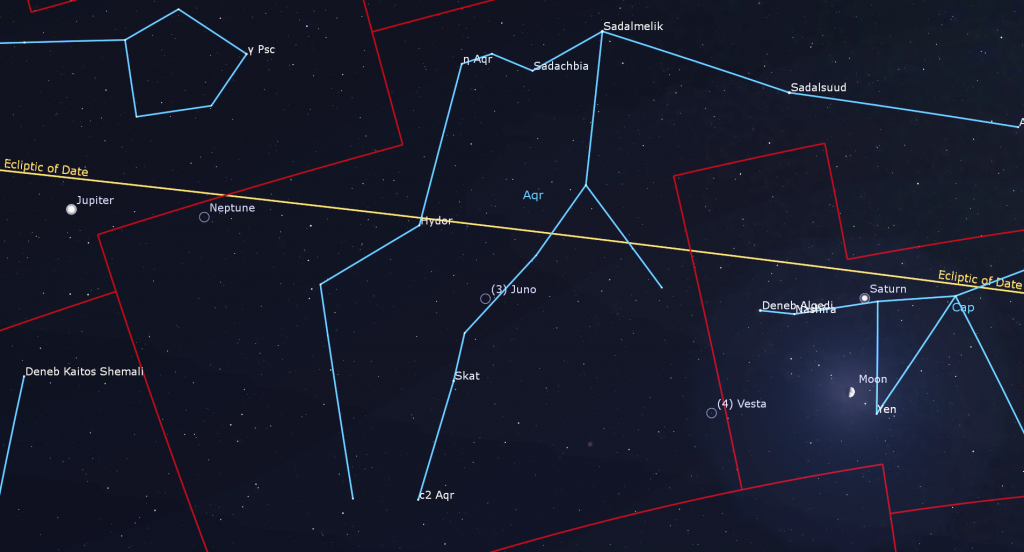
Use your binoculars to seek out a pentagon-shaped ring of stars shining about a fist’s diameter above Jupiter. They make up the western head of Pisces (the Fishes). All five stars should almost fit within your binoculars’ field of view. The brightest two stars are Iota Piscium (on the left) and Gamma Piscium (on the right). Those stars shine at about the magnitude limit that you can see without aid under suburban skies. The rest of Pisces forms a huge V of faint stars extending downward to Jupiter’s left (or celestial east).
A telescope can show you Jupiter’s dark belts and light bands, which are aligned parallel to its equator.
Jupiter’s Great Red Spot, a cyclonic storm that has raged for hundreds of years, is visible for several hours when it crosses the planet. Because Jupiter rotates once every 10 Earth-hours, the GRS appears every 2nd or 3rd night. You can see it with a good quality backyard telescope. For observers in the Americas, that GRS will cross Jupiter’s disk in early evening on Sunday, Tuesday, Friday, and Sunday, late on Monday, Thursday, and Saturday evening, and during the wee hours of Tuesday, Thursday, and Sunday. If you have any coloured filters or nebula filters for your telescope, try enhancing the GRS with them.
The small, black shadows of Jupiter’s Galilean moons are visible through a good backyard telescope when they cross the planet’s disk. For observers in the America’s, Io’s shadow will cross Jupiter’s equator, with the GRS, on Tuesday evening between 8:30 pm and 10:40 pm EDT. On Wednesday evening, sky-watchers located east of Calgary and Phoenix can watch two shadows crossing the southern hemisphere of Jupiter at the same time for about half an hour. At 8:25 pm EDT (or 00:25 GMT on November 3), the large shadow of Ganymede will join the small shadow of Europa, which began its own crossing of the planet two hours earlier. Europa’s shadow will leave Jupiter at 8:57 pm EDT (or 00:57 GMT), leaving Ganymede’s shadow to continue on alone until 11 pm EDT (or 03:00 GMT). Don’t forget to adjust these quoted times into your own time zone.
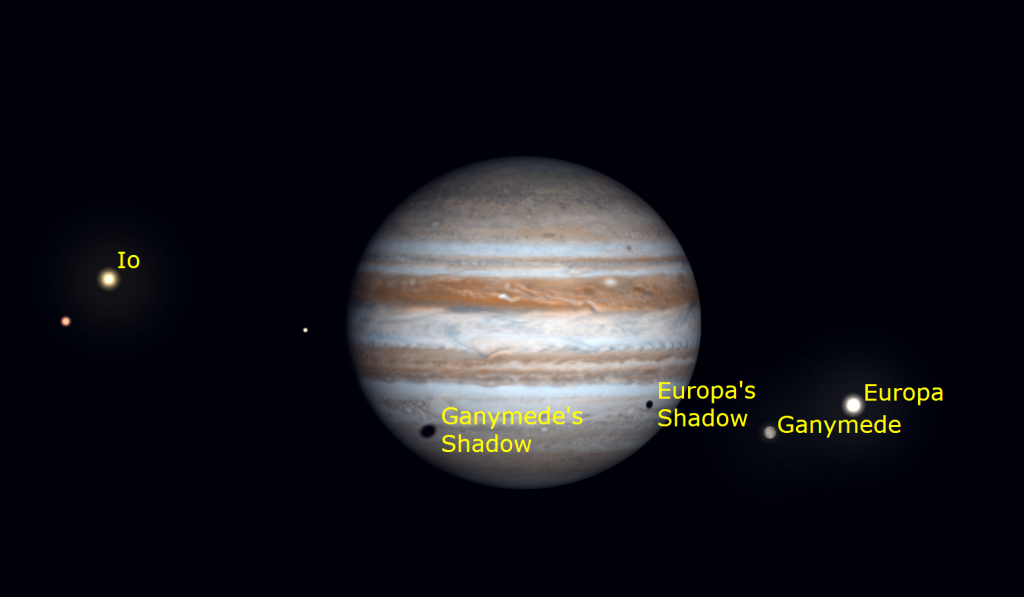
Jupiter is not alone in evening. After dusk, look in the lower third of the southern sky to see the much fainter, yellowish, medium-bright dot of magnitude 0.66 Saturn shining above the stars of Capricornus (the Sea-Goat). Saturn recently resumed its regular easterly prograde motion. In the coming months, it will slide to the left above the left-right pair of stars that form the sea-goat’s tail, Deneb Algedi (on the left, celestial east) and Nashira (on the right, celestial west).
Saturn will be highest in the south at 8 pm local time, and then it will set in the west after midnight. Very good binoculars should show Saturn and its rings as a tiny oval. On a good night, even a small telescope can show Saturn’s subtly banded globe encircled by its glorious rings, which are sufficiently edge-on to us to allow Saturn’s southern polar region to extend well beyond the ring plane. See if you can make out the Cassini Division, a narrow, dark zone that separates Saturn’s main inner ring (named B) from its bright outer ring (named A). Saturn’s position far to the west of the anti-solar point has caused the planet’s globe to cast a widening wedge of dark shadow onto the rings where they emerge from behind the eastern limb of the planet. Where you see that shadow will depend upon how your telescope flips and/or mirrors the view. In a refractor or SCT telescope, it’s toward the upper right. In a Newtonian reflector, it will be toward lower right. An equatorial mount will rotate the scene, too.
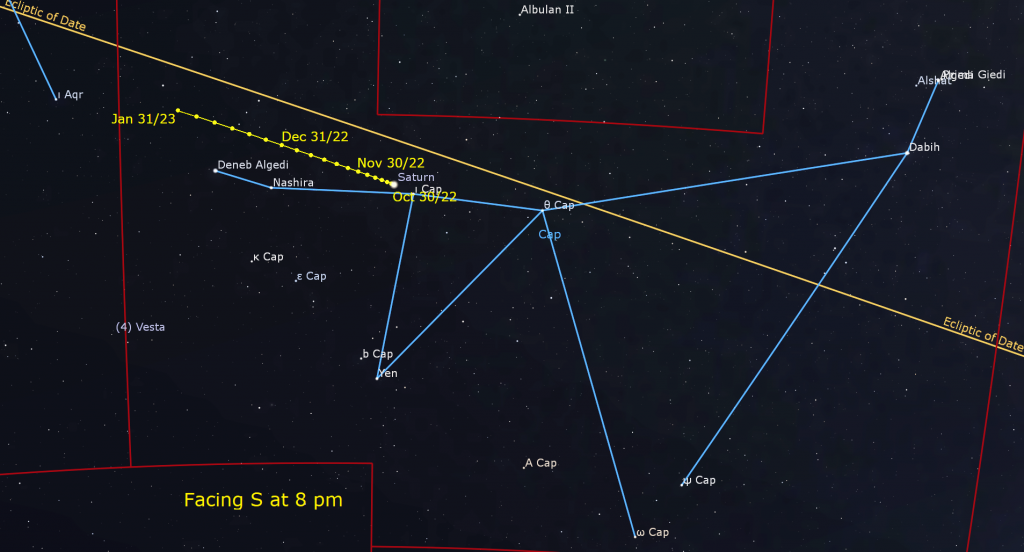
A small telescope can also show several of Saturn’s moons – especially its largest, brightest moon, Titan! From here on Earth, Saturn’s axial tilt of 26.7° lets us see the top of its ring plane, and allows its brighter moons to array themselves all around the planet. Titan never wanders more than five times the width of Saturn’s rings from the planet. The much fainter moon named Iapetus can stray up to twelve times the rings’ width during its 80-day orbit of Saturn. Iapetus has one dark hemisphere and one bright hemisphere. This week, that moon will appear brighter while its lighter half continues to face our direction.
The next brightest moons Rhea, Dione, Tethys, Enceladus, and Mimas all stay within one ring-width of Saturn. During evening this week, Titan will migrate counter-clockwise around Saturn, moving from the lower left (or celestial southeast) of Saturn tonight (Sunday) to the right (or celestial west) of Saturn next Sunday. (Remember that your telescope might flip that view around.) How many of the moons can you see in your telescope?
Mars is the challenger to Jupiter I mentioned above. As Earth’s faster orbit closer to the sun causes us to pass Mars on the inside track, we will draw closer to the red planet until November 30. We’re 93 million km (or 5.2 light-minutes) away from it this week. That decrease in distance will make Mars shine a little brighter in the sky and look a bit larger in telescopes every night! This week, the very red-looking, magnitude -1.2 planet will rise over the east-northeastern horizon around 8:30 pm local time. Then it will cross the sky all night and fade from view as dawn arrives, while it’s high in the southwest.
In late evening, look for the bright, orange-red star Aldebaran and the Pleiades star cluster, which are both part of Taurus (the Bull), shining to Mars’ upper right. The very bright yellow goat-star star Capella, with its three little “kids” stars will be shining to Mars’ upper left (or celestial north). Mars has begun a westerly retrograde loop that will last through its December opposition and into mid-January. All this week, Mars will be positioned between the two horn tips of the bull, the medium-bright stars Zeta Tauri and Elnath (Beta Tauri). Over the next month, you can watch Mars swing between those stars and then race west towards the Pleiades. Viewed in a telescope, Mars will show a waxing, 94%-illuminated disk. If the air is steady you might see some dark markings wrapping around the planet and the white patch of its northern polar cap.
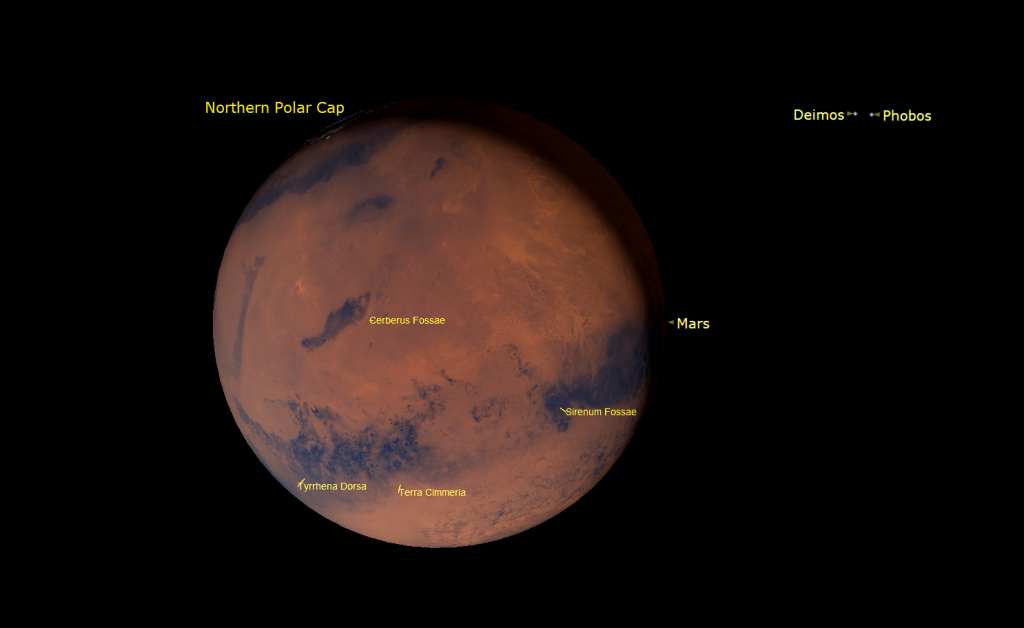
There are several fainter planets and asteroids lurking between the bright three. Magnitude 7.8 Neptune is located a generous palm’s width to the right (or 7° to the celestial west-southwest) of Jupiter, which will slide a wee bit closer to the distant planet every night. Neptune’s apparent disk size is 2.4 arc-seconds (20 times smaller than Jupiter’s). Try for Neptune while it is highest in late evening. I recently posted a finder chart for it here.
Uranus is located about midway between Mars and Jupiter, and about 1.3 fist widths to the upper right (or 13° to the celestial west-southwest) of the Pleiades star cluster. Closer guideposts to Uranus are several medium-bright stars named Botein (or Delta Arietis), Al Butain II (or Rho Arietis), and Sigma Arietis which will appear several finger widths from Uranus. Those stars mark the feet of the Aries (the Ram). The magnitude 5.7 planet will be high enough for telescope-viewing, in the lower part of the eastern sky, by 9 pm local time this week.
The large asteroids designated (4) Vesta and (3) Juno are currently between Jupiter and Saturn, too.

Halloween Treats for Binoculars and Backyard Telescopes
One of my favorite spooky objects can be seen in binoculars or a backyard telescope. It’s an open star cluster designated NGC 457 in W-shaped Cassiopeia (the Queen), but I prefer its common names – the Owl Cluster, ET Cluster, or Dragonfly Cluster. Cassiopeia is located high in the northeastern sky on autumn evenings. The star at the middle of the W is Navi or Gamma Cas. The next bright star below Navi is Ruchbah.
The Owl Cluster consists of two prominent, brighter yellow stars that form the eyes, a sprinkling of dimmer stars that form the owl’s body and feet, and two curved chains of stars that look like upswept wings. Be aware that the critter is positioned with its head pointing away from Cassiopeia. Locate the owl by taking the stars Navi and Ruchbah and making them the two vertices of a right-angle triangle. The cluster sits at the third vertex, where the 90 degree corner is. It’s about four finger widths above Ruchbah – as if the queen is bouncing a baby owl on her knee! Binoculars will show you a tiny bright patch dominated by those yellow eyes. A telescope will see her take flight!
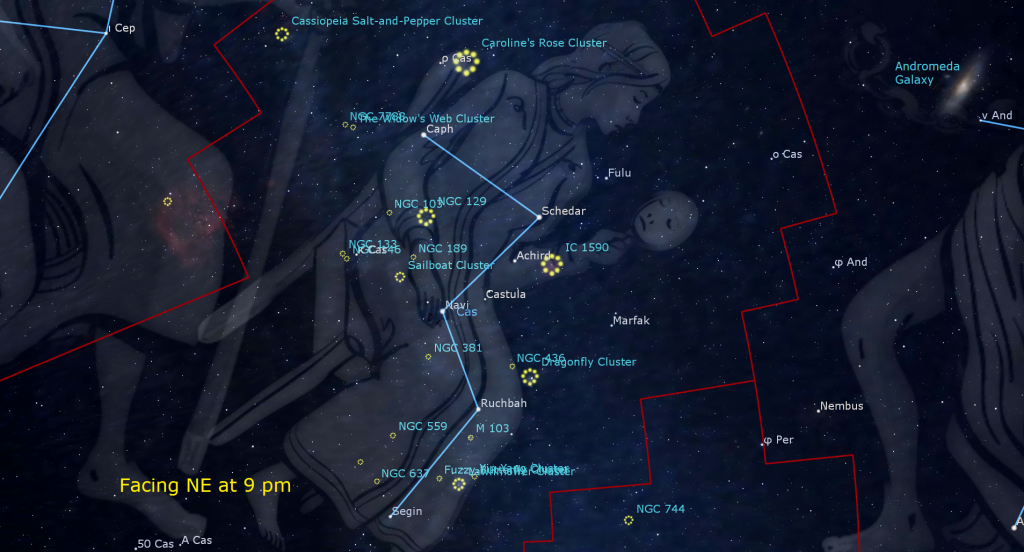
Cassiopeia is surrounded by many big, bright star clusters. I’ll post a chart showing them here. Scan around the W on the next clear night and see what treats you can scare up!
Public Astro-Themed Events
Every Monday evening, York University’s Allan I. Carswell Observatory runs an online star party – broadcasting views from four telescopes/cameras, answering viewer questions, and taking requests! Details are here. They host in-person viewing on the first clear Wednesday night each month. On Wednesdays they stream views online via the observatory YouTube channel. Details are here.
On Monday evening, October 31 from 7 to 8 pm EDT, York University’s Allan I. Carswell Observatory will present an in-person lecture and concert by Dr. Parandis Tajbakhsh entitled Herschel and the Haunted Telescope. The lecture will feature a live concert by three young violinists playing Herschel’s caprices no.1, 7, 11, 14 and 20. This in-person event will be at York University’s Curtis Lecture Hall G (CLH-G), 125 Campus Walk. Details and the Eventbrite tickets link are here.
From 9 pm to midnight on Monday, the Allan I. Carswell Observatory will continue the Halloween fun with a Halloween-themed tour of Allan I. Carswell observatory’s “Haunted Telescope” and a viewing session of Uranus, discovered by Sir William Herschel in 1781. A Separate ticket is required. Details are here.
Taking advantage of the crescent moon in the sky this week, the RASC Toronto Centre astronomers will hold their free monthly City Sky Star Party in Bayview Village Park (steps from the Bayview subway station), starting after dusk on the first clear weeknight this week (Mon, Tue or Thu only). Check here for details, and check the banner on their website home page or Facebook page for the GO or NO-GO decision around 5 pm each day.
On Wednesday evening, November 2 at 7:30 pm EDT, the RASC Toronto Centre will live stream their monthly Recreational Astronomy Night Meeting at https://www.youtube.com/rasctoronto/live. Talks include The Sky This Month, building a home observatory, a student project to analyze the Didymos impact test using public datasets, robotic telescope cameras, and math, and the mystery of the Martian flares. Details are here.
On Thursday, November 3 at 8 pm EDT, the Department of Astronomy & Astrophysics at the University of Toronto hold their AstroTour. The free, in-person event will feature Simran Nerval, a PhD candidate at the Dunlap Institute for Astronomy and Astrophysics and Department of Astronomy and Astrophysics at the University of Toronto. She will discuss The Growth Spurt of the Early Universe. An observatory tour will take place after the talk. The location is McLennan Physical Laboratories, Room MP202, 60 St George St, Toronto. Details are here.
RASC’s in-person sessions at the David Dunlap Observatory will soon be resuming! In the meantime they are pleased to offer some virtual experiences instead in partnership with Richmond Hill. The modest fee supports RASC’s education and public outreach efforts at DDO. Only one registration per household is required. Prior to the start of the program, registrants will be emailed the virtual program link.
On Sunday afternoon, November 6 from 11 am to noon EDT, join me for DDO Ask an Astronomer. During the family-friendly session, I’ll answer your questions about the universe and review what’s up nowadays. The deadline to register for this program is Wednesday, November 2, 2022 at 3 pm. More information is here and the registration link is here.
My free, family-friendly Insider’s Guide to the Galaxy webcasts with Samantha Jewett of RASC National returns on Tuesday, November 8 at 3:30 pm EDT. RASC President Charles Ennis has been creating a catalogue of the star patterns employed by a myriad of cultures around the world. He’ll join us as a special guest to take us through the project and share his favorites. You can find more details and the schedule of future sessions here.
Keep looking up, and enjoy the sky when you do. I love questions and requests. Send me some!